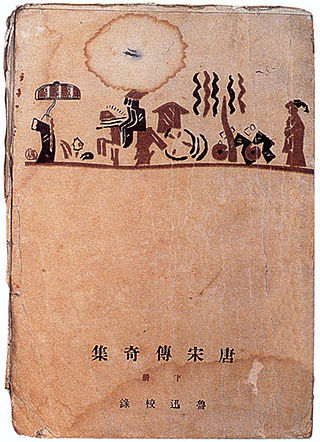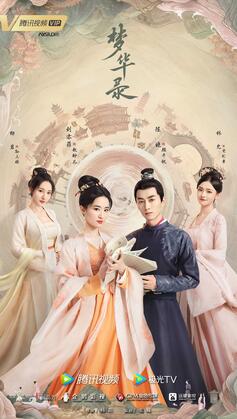Related Research Articles
The Chinese classics or canonical texts are the works of Chinese literature authored prior to the establishment of the imperial Qin dynasty in 221 BC. Prominent examples include the Four Books and Five Classics in the Neo-Confucian tradition, themselves an abridgment of the Thirteen Classics. The Chinese classics used a form of written Chinese consciously imitated by later authors, now known as Classical Chinese. A common Chinese word for "classic" literally means 'warp thread', in reference to the techniques by which works of this period were bound into volumes.

Song, known as Liu Song, Former Song (前宋) or Song of (the) Southern dynasties (南朝宋) in historiography, was an imperial dynasty of China and the first of the four Southern dynasties during the Northern and Southern dynasties period. It succeeded the Eastern Jin dynasty and preceded the Southern Qi dynasty.

The Taiping Guangji, sometimes translated as the Extensive Records of the Taiping Era, or Extensive Records of the Taiping Xinguo Period, is a collection of stories compiled in the early Song dynasty. The work was completed in 978, and printing blocks were cut, but it was prevented from official publication on the grounds that it contained only xiaoshuo and thus "was of no use to students." It circulated in various manuscript copies until it was published in the Ming dynasty. It is considered one of the Four Great Books of Song (宋四大書). The title refers to the Taiping Xinguo era, the first years of the reign of Emperor Taizong of Song.

The Liexian Zhuan, sometimes translated as Biographies of Immortals, is the oldest extant Chinese hagiography of Daoist xian "transcendents; immortals; saints; alchemists". The text, which compiles the life stories of about 70 mythological and historical xian, was traditionally attributed to the Western Han dynasty editor and imperial librarian Liu Xiang, but internal evidence dates it to the 2nd century CE during the Eastern Han period. The Liexian Zhuan became a model for later authors, such as Ge Hong's 4th century CE Shenxian zhuan.
Li Shishi (?-?) was a Gējì(Chinese: 歌妓 / 歌伎; pinyin: Jiǎojì) from Bianjing, the capital of the Song Empire. At the time, Gējì refers to women who engaged in the performing arts for a living, and their scope of work included: singing, dancing, reciting poetry and painting during the Northern Song dynasty. According to Gui Er Ji written by Zhang Duanyi, Emperor Huizong was a regular patron of hers. She fled to Zhejiang or Hunan after the Jingkang Incident of the Jin–Song wars occurred in year 1127 AD, as recorded in Mo Man Lu by Zhang Bangji.

Yueyang Tower is an ancient Chinese pavilion in Yueyang, Hunan Province, on the shore of Lake Dongting. Alongside the Pavilion of Prince Teng and Yellow Crane Tower, it is one of the Three Great Towers of Jiangnan. Yueyang Tower became famous for Memorial to Yueyang Tower (《岳阳楼记》) written by Fan Zhongyan, an eminent minister of the Northern Song dynasty (960–1127) in China.

"The Painted Skin" is a short story by the Chinese writer Pu Songling collected in Strange Tales from a Chinese Studio in 1740. Literary critics have recognised it as one of the best and best-known entries in Strange Tales; in particular, its textual detail and in-depth characterisation are lauded. "The Painted Skin" has also received numerous adaptations in popular media, especially in film. The story's original title has become a common phrase in Chinese vocabulary, "a synonym for duplicity that wears an outwardly human face but is inwardly demonic".

The Wen Xuan, usually translated Selections of Refined Literature, is one of the earliest and most important anthologies of Chinese poetry and literature, and is one of the world's oldest literary anthologies to be arranged by topic. It is a selection of what were judged to be the best poetic and prose pieces from the late Warring States period to the early Liang dynasty, excluding the Chinese Classics and philosophical texts. The Wen Xuan preserves most of the greatest fu rhapsody and shi poetry pieces from the Qin and Han dynasties, and for much of pre-modern history was one of the primary sources of literary knowledge for educated Chinese.
The Jizhong discovery was the accidental rediscovery in 279 AD of a corpus of bamboo and wooden slips, as attested in the Book of Jin. The slips were found by a grave robber named Biao Zhun (不準) who had broken into the tomb of King Xiang of Wei. The rediscovered texts enabled philological study among scholars that had been impossible since the editorial work of Han-era scholars Liu Xiang and Liu Xin. The importance of the discovery has been compared to that of the Guodian Chu Slips for modern scholarship.
A New Account of the Tales of the World, also known as Shishuo Xinyu, was compiled and edited by Liu Yiqing during the Liu Song dynasty (420–479) of the Northern and Southern dynasties (420–589). It is a historical compilation of anecdotes about Chinese scholars, musicians, and artists during the 2nd-4th centuries.
Sun Sheng (c.302–373), courtesy name Anguo, was a Jin dynasty historian. He was a native of Pingyao County, Jinzhong, Shanxi. He was described to be very studious, and was never seen without holding a book in his hand from his youth to his old age.
Zhiguai xiaoshuo, translated as "tales of the miraculous", "tales of the strange", or "records of anomalies", is a type of Chinese literature which appeared in the Han dynasty and developed after the fall of the dynasty in 220 CE and in the Tang dynasty in 618 CE. They were among the first examples of Chinese fiction and deal with the existence of the supernatural, rebirth and reincarnation, gods, ghosts, and spirits.

A Brief History of Chinese Fiction is a book written by Lu Xun as a survey of traditional Chinese fiction. It was first published in Chinese in 1925, revised in 1930, translated into Japanese, Korean, German, and then into English in 1959 by Gladys Yang and Yang Xianyi. It was the first in-depth survey of Chinese fiction to be published in China, and has been influential in shaping later scholarship.

Bao Zhao was a Chinese poet, writer, and official known for his shi poetry, fu rhapsodies, and parallel prose who lived during the Liu Song dynasty (420–479). Bao's best known surviving work is his "Fu on the Ruined City", a long fu rhapsody on the ruined city of Guangling.

Bowuzhi by Zhang Hua was a compendium of Chinese stories about natural wonders and marvelous phenomena. It quotes from many early Chinese classics, and diversely includes subject matter from Chinese mythology, history, geography, and folklore. The Bowuzhi, which is one of the first works in the literary genre of zhiguai "tales of anomalies; supernatural stories", records the earliest versions of several myths, such as the white yenü 野女 "wild women" living south of China in a society without men. Scholars have described the Bowuzhi as "a miscellany of scientific interest" and "an important minor classic".

Yang Yiqing, courtesy name Yingning (應寧), pseudonym Sui'an (邃庵) or Shizong (石淙), was a Chinese scholar-official of the Ming dynasty.

Chuanqi is a form of fictional short story in Classical Chinese first formed in the Tang dynasty. The term often refers specifically to fictions written in the Tang dynasty, in which case the fictions are also called Tang chuanqi or chuanqi wen. Chuanqi originated from the Zhiguai xiaoshuo of the Six Dynasties, was first formed in Early Tang dynasty, became popular in Middle Tang and dwindled in the Song dynasty. Chuanqi has four main themes: love, gods and demons, xiayi and history. Well known works of chuanqi include The World Inside a Pillow and Renshi zhuan by Shen Jiji, Yingying's Biography by Yuan Zhen, The Tale of Huo Xiaoyu by Jiang Fang, The Tale of Li Wa by Bai Xingjian, The Governor of Nanke by Li Gongzuo, Chang hen ge zhuan by Chen Hong, Hongxian zhuan by Yuan Jiao and The Tale of the Curly-Bearded Guest by Du Guangting. Unlike general Biji xiaoshuo and Zhiguai xiaoshuo, most chuanqi stories have a complicated plot with twists and detailed descriptions and are meaningful literary creations instead of mere recordings of factual events. They are some of the earliest Chinese literature written in the form of short stories and have provided valuable inspiration plot-wise and in other ways for fiction and drama in later eras. Many were preserved in the 10th-century anthology, Taiping Guangji.

Liu Chen (劉晨) and Ruan Zhao (阮肇) were semi-legendary figures active during the Han dynasty, known for their trip to Tiantai Mountain. First described in the early fifth-century zhiguai anthology Youming lu (幽明錄), the legend of Liu Chen and Ruan Zhao has been depicted in paintings, plays, and poetry.

A Dream of Splendor is a 2022 Chinese historical drama television series directed by Yang Yang and starring Liu Yifei, Chen Xiao, Liu Yan and * Lin Yun. Set in the Northern Song Dynasty, the series is based on the drama Zhao Pan'er Fengyue Jiu Feng Chen《赵盼儿风月救风尘》 by the Yuan Dynasty playwright Guan Hanqing. It is airing on Tencent Video and WeTV from June 2, 2022 to July 24, 2022. Hong Kong's TVB was the first television station to broadcast this drama on TVB Jade from September 5, 2022 to October 14, 2022, previously on its streaming service MyTV SUPER from June 9 to July 2, 2022. It later went on national broadcast and aired simultaneously on Beijing Satellite Television from 22 November 2022.

"Judge Lu" is a short story written by Pu Songling (1640–1715) and first published in 1766 in Strange Tales from a Chinese Studio. It revolves around a scholar and his friendship with a judge from the underworld, who performs a heart transplant on him and a head transplant on his wife. The story was translated into English by Herbert Giles in 1880.
References
Sources
- Campany, Robert Ford (1996). Strange writing : anomaly accounts in early medieval China. Albany: State University of New York Press. ISBN 0-585-04274-8. OCLC 42854730.
- Knechtges, David R.; Chang, Taiping, eds. (2010). Ancient and early medieval Chinese literature : a reference guide. Leiden [Netherlands]: Brill. ISBN 978-90-04-19127-3. OCLC 649419201.
- Zhang, Zhenjun (2014). Buddhism and tales of the supernatural in early medieval China : a study of Liu Yiqing's (403-444) Youming lu. Leiden: Brill. ISBN 978-90-04-27784-7. OCLC 892340447.